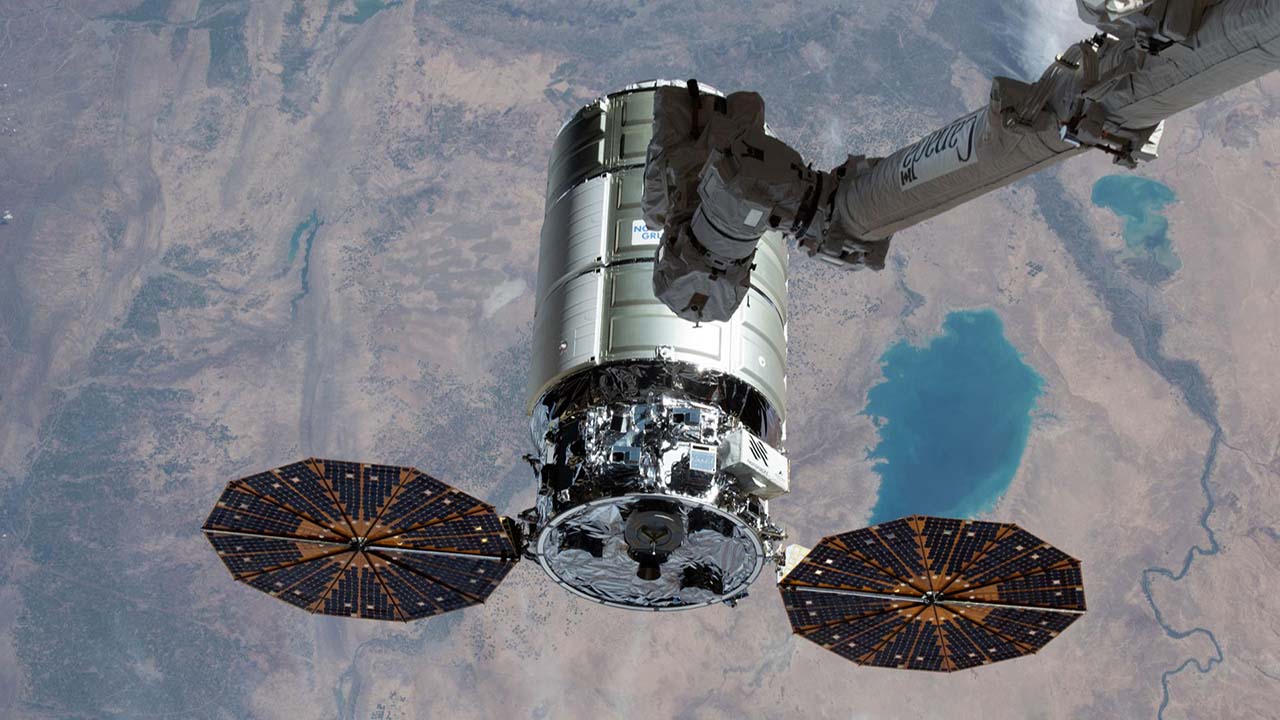More than a dozen payloads representing diverse research areas will launch to the International Space Station (ISS) onboard Northrop Grumman’s 20th Commercial Resupply Services mission contracted by NASA. The launch is planned for no earlier than 12:29 p.m. EST on January 29, 2024, from Space Launch Complex 40 at Cape Canaveral Space Force Station in Florida. Below highlights ISS National Lab-sponsored research flying on this mission.
Genes in Space Molecular Operations and Sequencing (GiSMOS)
Boeing
Principal Investigators (PIs): Scott Copeland and Sarah Wallace
Through this investigation, Boeing aims to expand the capabilities of the Genes in Space™ annual student competition by testing protocols that build on previously flown experiments. Using samples collected from the space station’s Water Recovery System (WRS), the team will create the first accurate and complete genomic profile of the WRS. Additionally, this project will provide students participating in the competition with more avenues to explore.
IP: Boeing
Engineering Multiple-Compartment Cartilage Tissue Construct
University of Connecticut
PI: Dr. Yupeng Chen
This project, funded by the U.S. National Science Foundation (NSF), will test the efficacy of a DNA-inspired Janus base nanomaterial that may help repair cartilage in space. Microgravity can induce the same type of cartilage deterioration observed in patients with degenerative joint diseases. Results from this investigation could lead to improved treatments for patients on Earth as well as astronauts on long-duration missions.
IP: Space Tango
Evaluations of Bacteriorhodopsin Semi-Crystalline Lattices in Microgravity
LambdaVision
PI: Dr. Nicole Wagner
This project aims to examine a new method of transporting bacteriorhodopsin, the key protein component of LambdaVision’s artificial retina, which is designed to restore significant vision in patients with retinal degenerative diseases. Building on previous space station research by LambdaVision, this project seeks to determine if a powered form of the protein can be resuspended in solution in microgravity. Results will help inform the company’s plan to scale up production while ensuring that high-quality implants can be manufactured from raw materials in space.
IP: Space Tango
Advancing SpaceFiber Manufacturing in Microgravity Onboard the ISS
Flawless Photonics, Inc.
PI: Dr. Michael Vestel
This investigation will leverage the space station to test microgravity-based glass drawing processes on a Flawless Photonics ZBLAN manufacturing platform. The project’s goal is to demonstrate the theorized benefits of manufacturing ZBLAN fibers in microgravity to effectively eliminate gravity-induced defects. By harnessing the unique environment of microgravity, Flawless Photonics aims to produce fibers that offer significantly enhanced performance for a wide range of applications, including advanced laser systems and telecommunications devices for both space and Earth applications.
IP: Visioneering Space Corporation
Spaceborne Computer-2
Hewlett Packard Enterprises (HPE)
PI: Dr. Mark Fernandez
Hewlett Packard Enterprise (HPE) will test an updated version of HPE Spaceborne Computer-2, a commercial off-the-shelf supercomputer based on HPE EdgeLine and ProLiant servers. HPE Spaceborne Computer-2 is equipped with software that enables performance in the harsh environment of space. Results from this investigation could streamline space-based research by providing quicker in-orbit data processing. Insight gained could also enable high-performance computing on future long-duration missions.
Nanoracks – GITAI S2
Nanoracks and GITAI Japan, Inc.
PI: Christopher Cummins
An investigation from space robotics startup GITAI Japan, Inc. will evaluate how efficiently its dexterous robotic arm technology operates outside of the space station. This project aims to demonstrate that GITAI’s extravehicular robotic systems are capable of functioning in the space environment. A pair of robotic arms will perform a series of common crew activities and tasks via supervised autonomy and teleoperations from the ground.
IP: Nanoracks
Rhodium Crystal Preservation-02
Rhodium Scientific
PIs: Olivia Gamez Holzhaus and Dr. Heath Mills
This investigation aims to use crystal growth in microgravity to advance a novel technique to preserve biological material. Conducting research in remote environments like the space station can make it difficult to get samples back to a ground lab for analysis due to constrained resources like access to cold stowage. Building on previous research, this project aims to advance a method that uses a crystal matrix to preserve biologicals material so they can remain stable at room temperature for long periods of time. This would circumvent the need for cold stowage, which would make the return of samples much easier. Results from this investigation could establish a reproducible, predictable method for future use of this novel preservation technique for biological materials.
Manufacturing of Semiconductors and Thin-Film Integrated Coatings (MSTIC)
Redwire Corporation
PI: Alex Hayes
This project examines the effects of microgravity on deposited thin films used in semiconductor manufacturing. Manufacturing these films in microgravity may improve their quality and reduce the materials, equipment, and labor required. The investigation also explores differences in the microstructure of thin films produced in microgravity and on the ground.







